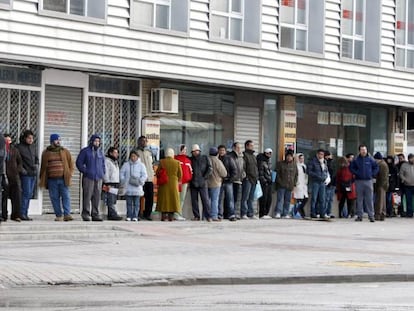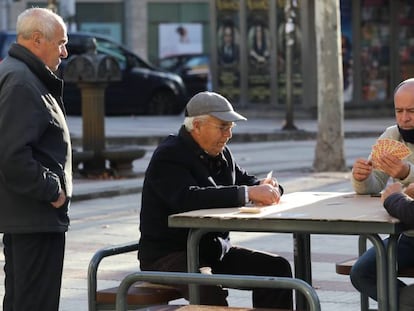Growing up in Spain’s poorest neighborhood
Strikes, violence and drugs combine to threaten the futures of youngsters in Los Pajaritos in Seville
When the sun sets, the people of Los Pajaritos leave their homes to hang out on the streets. There are no libraries or civic centers in this neck of the woods nor do the squares have fountains. Instead, the locals buy sunflower seeds and beer from a kiosk and find a bench. “Los Pajaritos is never going to get a make over,” says Cristina Anglada, 17.
Cristina, comes to Los Pajaritos to score hash. She doesn’t live here whereas her friend Sandra Rodríguez, 20, was born and bred in the neighborhood. “People from outside see us as a marginalized area, but it is not like that,” she says.
When night falls, it’s like something from 'The Walking Dead'. If you can, you get out Resident Antonio de Los Santos
In 2017, Los Pajaritos was once again registered by authorities as the poorest area in Spain. The average income per family is €12,307 a year, according to the latest report by the National Institute of Statistics (INE) which looks at the districts of 16 Spanish municipalities with more than 250,000 inhabitants.
“The youngsters who live here are typically between 20 and 25 with no work experience,” says Salvador Muñiz, president of the Tres Barrios-Amate neighbor’s association. “They depend either on the family or their grandparents’ pensions for money. Around 60% have dropped out of school.”
Tres Barrios, which encompasses Los Pajaritos as well as La Candelaria, Madre de Dios and Amate, has a population of 22,000 and an unemployment rate of over 50% and young people are the hardest hit. These dire circumstances motivated Sandra to study social interaction.
“When you have people doing nothing all day, they end up taking drugs or drinking. We need to provide courses that will lead to jobs,” she says. “This area is stigmatized. There are a lot of hypocrites who come here to buy drugs but leave within seconds. They think they’ll get robbed, but that’s not so at all. It’s not a ghetto.”
The average income per family is €12,307 a year
Despite her defense of the neighborhood, she does admit that most youngsters will end up in the drug trade. “It’s what they see and what they go on to do,” she says. “In my case, I was able to study. Despite the obstacles, you can if you want to. The environment and the neighborhood have the power have an influence but they do not determine who you are.”
Drugs have been Los Pajaritos’ principal problem since the 1980s when a heroin epidemic gripped many of Spain’s less privileged areas. Now, trafficking takes place in a wide number of homes with constant comings and goings. “Traffickers from Tres Mil Viviendas have started to come here to buy property and build their business,” says Muñiz, referring to a notorious area to the south of the city.
It’s a business that many youngsters will get a start in as adolescents. According to 22-year-old Jesus Jurado, who is pleased to be able to earn easy money, there are one or two apartments selling drugs in every building. Apparently, his own apartment was raided by police just a short while back. “They got the wrong place,” he says. “They were after the guy who lives opposite, so they’re going to pay for the door and the sofa they broke.”
Jesus says he feels safe living in the neighborhood as everyone knows him but when it comes to his father-in-law’s bar, he admits that the restocking trucks are loathed to go in. In fact, he has a nine-month-old son and hopes to move out of the area before it’s too late. “It’s true this is the poorest neighborhood in Spain, but it’s also the neighborhood with the most black money in the country,” he says.
The rate of truancy is another issue the authorities are trying to tackle. Lourdes Ruiz Parejo, a social worker in the area, says that one of her biggest challenges is to get children to go to school. “You have to take into account that the needs around here are very basic,” she says. “Water, electricity, clothes and food.”
According to Muñiz, around 40% of homes are illegally tapping the electricity grid. And his association delivers food three times a year to 500 families. “The 10th of every month is the only day when people can breathe easily, since that is when they get their welfare money and a bit of help,” he says.
I don’t know what’s going to happen from one day to the next but I work every day at becoming who I want to be Waiter Carlos de Jesús Ramírez
Antonio de Los Santos, 34, has lived here for seven years after buying a flat for €20,000, but he’s keen to clear out. He has had his car stolen and also broken into. “During the day, it’s almost normal here,” he says. “But when night falls, it’s like something from The Walking Dead. If you can, you get out.”
Eleven people have been killed here since 2000, making Los Pajaritos Seville’s most violent neighborhood. The last murder was committed last July – a woman turned up in some bushes in the Amate Park having been strangled and then burned.
“I like the area because I’m from here,” says Carlos de Jesús Ramírez, a waiter from the Dominican Republic who writes rap songs on life in Los Pajaritos. “There’s a lot of drugs, fights and robberies and a heavy police presence with many arrests, both warranted and not. If you want a better life, you have to move.”
Having said that, Carlos – aka Kenzi Oficial – is optimistic. He is a firm believer that youngsters are responsible for their own future. “A lot of young people either sell drugs or steal,” he says. “Their future is jail or death. I don’t know what’s going to happen from one day to the next but I work every day at becoming who I want to be.”
He does, however, concede that the environment poses a challenge. “The neighborhood is bad,” he says. “But we can’t let it influence us. We have to get out from under the meanness to construct something good. I love and live music and I’m working towards being the kind of singer I want to be. The thing is to move forward in life.”
Sat on a step, he plays some of his music, then talks some more about the difficulties his friends and family face. But he is adamant that the general levels of lawlessness are not going to bring him down. “I may be small,” he says. “But I dream big.”
English version by Heather Galloway.
Tu suscripción se está usando en otro dispositivo
¿Quieres añadir otro usuario a tu suscripción?
Si continúas leyendo en este dispositivo, no se podrá leer en el otro.
FlechaTu suscripción se está usando en otro dispositivo y solo puedes acceder a EL PAÍS desde un dispositivo a la vez.
Si quieres compartir tu cuenta, cambia tu suscripción a la modalidad Premium, así podrás añadir otro usuario. Cada uno accederá con su propia cuenta de email, lo que os permitirá personalizar vuestra experiencia en EL PAÍS.
¿Tienes una suscripción de empresa? Accede aquí para contratar más cuentas.
En el caso de no saber quién está usando tu cuenta, te recomendamos cambiar tu contraseña aquí.
Si decides continuar compartiendo tu cuenta, este mensaje se mostrará en tu dispositivo y en el de la otra persona que está usando tu cuenta de forma indefinida, afectando a tu experiencia de lectura. Puedes consultar aquí los términos y condiciones de la suscripción digital.
More information
Archived In
Últimas noticias
Science seeks keys to human longevity in the genetic mixing of Brazilian supercentenarians
Luisa Neubauer, climate change activist: ‘Ecology shouldn’t be a punitive force, but a joyful and liberating one’
Trump followed CIA recommendation to hand power to Delcy Rodríguez due to risk that Machado would not control the army
The Motherwell painting that Franco wanted to hide from view
Most viewed
- Alain Aspect, Nobel laureate in physics: ‘Einstein was so smart that he would have had to recognize quantum entanglement’
- Alvin Hellerstein, a 92-year-old judge appointed by Bill Clinton, to preside over Maduro’s trial in New York
- Cuba confirms death of 32 of its citizens in the US attack against Venezuela
- Gilles Lipovetsky: ‘If you want to live better and fall in love, take Prozac, don’t look to philosophy’
- Why oil has been at the center of Venezuela-US conflicts for decades











































